







Date: October 22, 2011
Location: Shot
Rock at 7600 feet
NELM: 7.1
7.2
Transparency:
4/5
Seeing: 3/5
Telescope: 22
f/4.0 reflector on an equatorial platform
Eyepieces: 24mm Panoptic
(finder eyepiece), 10 and 6mm ZAO-IIs, 9 and 7mm BGOs,
6mm Delos and 1.8x TMB ED Barlow.
Observed
a mix of galaxy trios and other interesting objects.
Note: All object parameters in parenthesis are listed in RA, Dec, size and listed magnitude without commas.
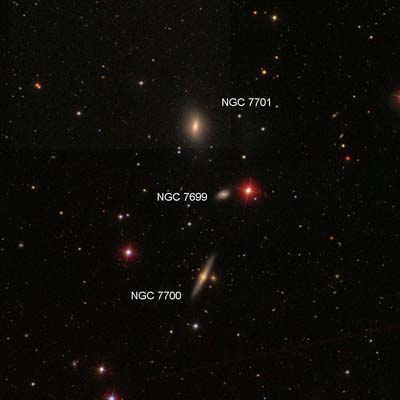 NGC 7700/7669/7701 trio
NGC 7700/7669/7701 trio
22 f/4 (230, 255 and 383x) A trio of three different classification of galaxies arranged in a very flat isosceles triangle. A mag 11.9 star is just west of the apex of the triangle.
NGC 7700 (23 34 30 -02 57 12 2.0x0.4 15.1) Bright 3:1 elongated high surface brightness glow with sharply defined edges. Stellar Core. PA = 150 and 0.9 long.
NGC 7699 (23 34 27.1 -02 53 58 0.7x0.5 15.9) Faint, small round glow with no central brightening. Even surface brightness. 0.3 across and a mag 11.9 star lies 1.0 due west.
NGC 7701 (23 34 31.5 -02 51 17 1.0x0.5 14.4) Considerably faint, low surface brightness diffuse glow. 3:2 elongated. PA = 0 and 0.5 long.
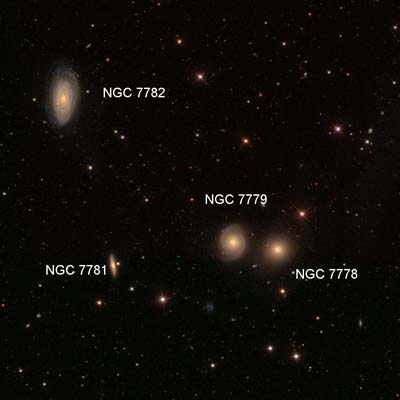 NGC 7778/79/81 trio
NGC 7778/79/81 trio
22 f/4 (230, 255 and 383x) This trio is dominated by two bright ellipticals anchored by a high surface brightness edge on.
NGC 7778 (23 53 19.7 +07 52 15 1.0x0.9 13.7b) Considerably bright round glow with a brighter center ending in a stellar core. Defined edges. About 0.6 across.
NGC 7779 (23 53 26.8 +07 52 32 1.4x1.0 13.7b) A little larger than NGC 7778. Considerably bright round glow with a brighter center. Defined edges. About 0.7 across.
NGC 7781 (23 53 46.0 +07 51 38 0.7x0.2 15.0b) Bright 3:1 elongated glow with well-defined edges and a brighter center. PA = 10 and 0.6 long. A mag 14.8 star lies just 0.2 WNW from the center.
Nearby galaxy, NGC 7782 (23 53 54.0 +07 58 11 2.4x1.2 13.1b) Bright large 3:2 elongated glow with a slightly brighter center. Some mottling was seen.
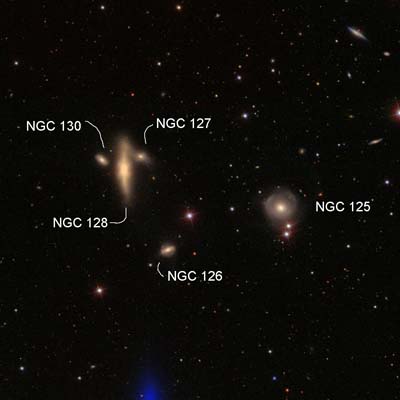 NGC 128/27/30 trio
NGC 128/27/30 trio
22 f/4 (230, 255 and 383x) This is almost a trio within a larger trio (with NGC 126 and NGC 125) The core trio is a very nice bright edge on barred spiral with two small elliptical companions flanking each side to the NE and NW. NGC 126, 125 and 127 forms a wide loosely arranged 30-60 right triangle with the hypotenuse of 6.5 long.
NGC 128 (00 29 15.1 +02 51 50 2.7x0.8 12.8b) Very bright glow with a high surface brightness box core and the extensions starts as fairly high surface brightness, then quickly fades. 1.6 long and the box is 0.3 wide. PA = 0
NGC 127 (00 29 12.4 +02 52 21 0.8x0.5 15.3) Considerably bright round even surface brightness glow. 0.2 across.
NGC 130 (00 29 18.6 +02 52 13 0.7x0.3 14.9) Considerably bright 3:2 elongated glow with a dominant stellar core. PA = 45 and 0.3 long.
NGC 126 (00 29 08.1 +02 48 40 0.7x0.5 15.2p) Considerably faint, 2:1 elongated even surface brightness glow with somewhat defined edges. PA = 100 and 0.3 long
NGC 125 (00 28 50.2 +02 50 19 1.6x1.4 13.1b) Considerably bright, round glow with a brighter center. Diffuse edges. 0.7 across.
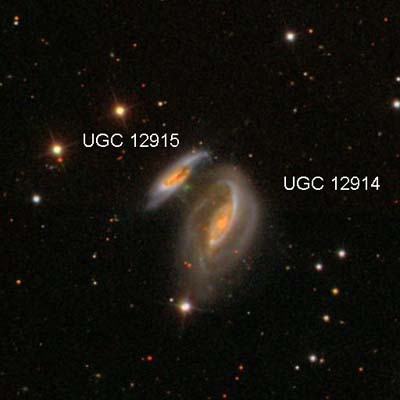 UGC 12914/15 (Taffy
Galaxies)
UGC 12914/15 (Taffy
Galaxies)
22 f/4 (230, 255 and 383x) This pair of interacting galaxies shows interesting structure. The northwest end is almost connecting.
UGC 12914 (00 01 37.9 +23 29 05 2.3x1.2 13.1p) Bright 3:1 elongated center part surrounded by a very faint 2:1 elongated halo. The brighter part has a stellar core and a very small bright extension on the NE tip. Overall it is 1.6x1.2 across with the brighter part being 1.0x0.4 across. PA = 135.
UGC 12915 (00 01 42.2 +23 29 42 1.5x0.6 13.9p) Considerably bright 3:1 elongated glow with a bright compact round center. There is a small extension on the NE tip that is slightly curved towards UGC 12914. PA = 120 and 1.0 long.
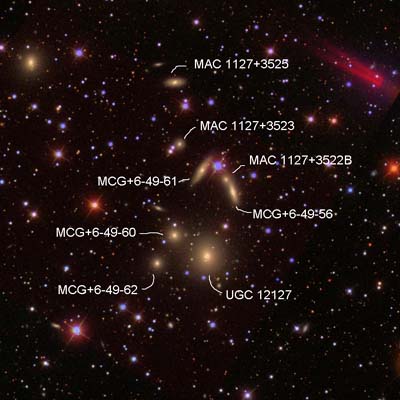 UGC 12127 (group near NGC
7331)
UGC 12127 (group near NGC
7331)
22 f/4 (230, 255, 383 and 690x) This is a nice compact group of eight galaxies that lies about a degree NNE of NGC 7331. There are more nearby, but these 8 are the ones I focused on. Ill start with the brightest member. A bright mag 11 star is in the middle, just next to one of the galaxies.
UGC 12127 (22 38 29.4 +35 19 49 1.3 14.4p) Bright round glow with a brighter center and very diffuse edges. 0.9 across.
MCG+6-49-60 (22 38 34.9 +35 20 29 0.5 15.0) Considerably faint, small round glow. 0.2 across.
MCG+6-49-62 (22 38 37.7 +35 19 33 0.4 16.0) Faint very small round glow with defined edges. 0.1 across.
MCG +6-49-56 (22 38 25.2 +35 21 57 1.5x0.5 15.9) Considerably bright 3:1 elongated even surface brightness glow. PA = 15 and 0.6 long.
MAC 2238+3522B (22 38 26.6 +35 22 22 0.3 16.1) This MAC is nearly attached to the north end of MCG+6-49-56. Very faint very small diffuse round glow. 0.1 across. The mag 11 star is just 0.5 NE.
MCG+6-49-61 (22 38 30.2 +35 22 41 1.3x0.4 15.7) Considerably bright 3:1 elongated even surface brightness glow with a faint almost stellar core. PA = 135 and 0.6 long.
MAC 2238+3523 (22 38 34.2 +35 23 33 0.4 16.0) Faint very small round even surface brightness glow. 0.1 across. A pair of 14th mag star lies just west.
MAC 2238+3525 (22 38 34.9 +35 25 37 1.1x0.4 15.5) Considerably faint, 2:1 elongated even surface brightness glow. PA = 90 and 0.3 long.
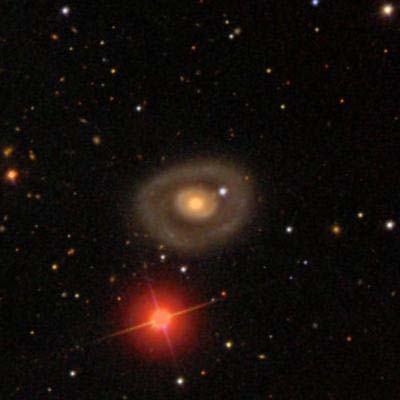 IC 5285 (ring galaxy) (23 06 58.7 +22 56 14 1.6x1.2 13.6b)
IC 5285 (ring galaxy) (23 06 58.7 +22 56 14 1.6x1.2 13.6b)
22 f/4 (230 and 383x) Bright slightly elongated glow with stellar core. A 14.8 mag star lies just to the NW of the glow. 0.5 long and PA = 90. The ring was not detected as it would be just outside of the 14.8 mag star.
Nearby galaxy, NGC 7489 (23 07 32.6 +22 59 50 2.1x1.1 14.0p), is a considerably faint 2:1 elongated low surface brightness glow with a faint nearly stellar core. PA = 170 and 0.7 long.
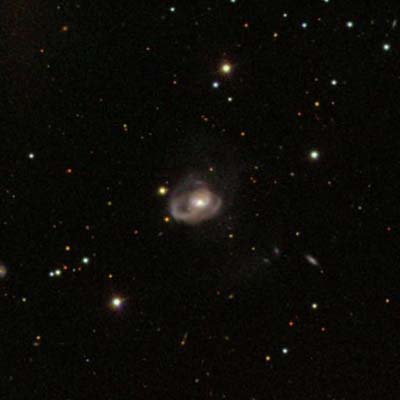 UGC 6 (ring galaxy with a
hook) (00
03 09.6 +21
57 39 0.9x0.6 14.4b)
UGC 6 (ring galaxy with a
hook) (00
03 09.6 +21
57 39 0.9x0.6 14.4b)
22 f/4 (383x) Considerably faint glow with a slightly offset brighter core. The core is offset to the west. About 0.6 long and PA = 90. A 14.6 mag star lies just off the NW edge. The hook detail was not detected.
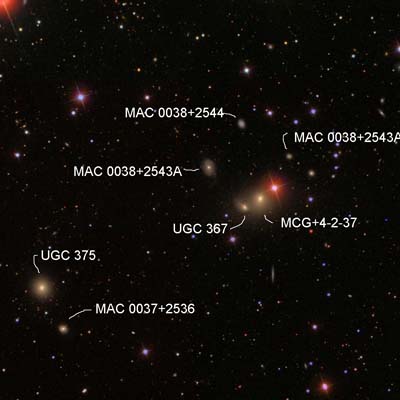 MCG+4-2-37, UGC 367/375 trio
MCG+4-2-37, UGC 367/375 trio
22 f/4 (230, 255 and 383x) In the field of this widely spaced trio, there were at least three faint MAC galaxies in the field. Actually there was one other, MAC 0037+2543, which I did not see. Ill start off my listing my observations with the actual trio.
MCG+4-2-37 (00 37 05.5 +25 41 56 0.8 14.5) Considerably bright round glow with a nice compact brighter core. 0.3 across. A blazing mag 10.6 star lies just 0.7 NW.
UGC 367 (00 37 08.2 +25 41 36 0.4x0.3 14.9p) Faint small round glow with diffuse edges. 0.2 across. This galaxy lies just 0.7 SE from the MCG. The star actually inhibits this galaxy more than the MCG, despite that MCG is in between.
UGC 375 (00 37 43.9 +25 38 24 0.8 14.9) Considerably bright diffuse round glow. About 0.3 across.
MAC 0037+2536 (00 37 40.1 +25 36 47 0.4x0.3 16.0) This galaxy lies 2.0 SSE from UGC 375. Faint small round glow. 0.2 across.
MAC 0037+2543A (00 37 14.6 +25 43 11 0.6x0.3 16.5) Faint round glow with very diffuse edges. Slightly brighter center. 0.2 across. Lies 2.4 ENE from the MCG.
MAC 0037+2544 (00 37 08.9 +25 44 58 0.4x0.3 17.0) Very faint small round diffuse glow. 0.1 across.
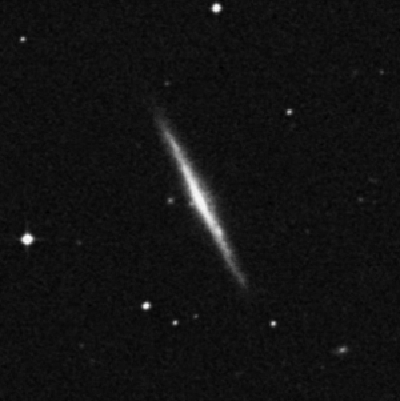 MCG-1-10-35 (flat galaxy) (03 46 36.0 -04 27 10 2.5x0.3 15.0)
MCG-1-10-35 (flat galaxy) (03 46 36.0 -04 27 10 2.5x0.3 15.0)
22 f/4 (230, 255 and 383x) Considerably faint even surface brightness long thin streak with no central brightening. PA = 30 and 2.0 long. A pair of 14th mag stars lies 2.2 east.
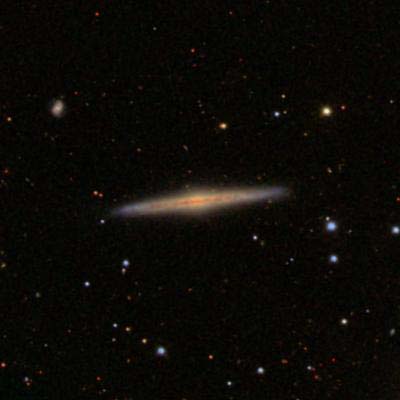 IC 2098 (flat galaxy) (04 50 44.2 -05 25 07 2.5x0.2 14.5)
IC 2098 (flat galaxy) (04 50 44.2 -05 25 07 2.5x0.2 14.5)
22 f/4 (230, 255 and 383x) Very faint and very low surface brightness thin glow. Note: This object as about 20 degree above the horizon when I observed this object. PA = 90 and 1.4 long. Two bright 11.0 and 11.4 stars lies nearby; one 4.5 SW and other is 5.0 slightly east of north.
Back to Observing Reports
All Observing Reports are copyrighted by Alvin Huey. You can print them for personal use only.
Components Aids Guides Observing Guides Reports
